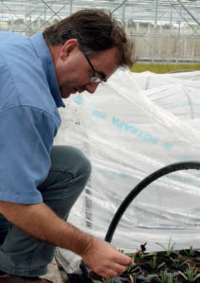Respected Nursery-man and industry commentator, Pat FitzGerald, sets out a 10 point strategy for protecting the future of commercial horticulture in Ireland.
When the Editor asked me to contribute to the first issue of Horticulture Connected, my initial reaction was NO! There’s nothing left to say, it’s all been said before. Memories of meetings held 20 years ago came back, and I thought, what’s the point in repeating the same old stuff? Surely my energy is better spent on developing my own business. My first reaction – although shaped through my personal experience over the years – is also symptomatic of one of the fundamental issues which undermine our sector and set it apart from related and more well-attended business sectors. Agriculture springs to mind.
Perhaps against my better judgment, and in the interests of stimulating action rather than comment, I relented to editorial pressure. Below is a list of ten points which I feel should form the cornerstone for an Irish horticulture strategy. Given my area of expertise, I have focused more on nursery production.
1. DONT REINVENT THE WHEEL
The first action to be undertaken should be a comprehensive and industry-wide review of the original Bord Glas Report produced in 1990. This report was extensive and in my opinion well thought out at its time. Much of it is still relevant in broad terms today. Re-examining the report will help to highlight a number of things. Much of what we should be doing has already been thought out, but not implemented; that many industry people invested heavily in the document and were never acknowledged, and the lack of implementation seriously undermined motivation for future participation. Collaboration between businesses was seriously undermined in the past and this needs addressing.
2. GET OUR FACTS STRAIGHT
To my knowledge, there is no hard data on the value of Irish horticulture. The same old farm gate estimates are trotted out each year and this is seriously undermining the whole sector.
We need a comprehensive assessment of the true value of the industry, encompassing actual sales, services, tourism, parks, gardens, attractions and all the indirect financial, social and health benefits derived from the horticultural activity. Until this is completed, no policymaker or decision maker can be expected to look positively on the sector. To give you some insight into the poor data collation, I contacted the CEO of Tourism Ireland who was able to provide me clear, unambiguous figures. It’s starting to look like these figures are not being used for industry promotion.
3. COMMUNICATE WITH THE PEOPLE THAT MATTER
The sector needs to work with organisations such as the IFA, Agri Aware and Bord Bia to develop a continual conversation with the consumer and public. We need to look at how best each of the sub-sectors can develop a unified or at least a similar strategy, to deliver this objective. This needs an annual funding mechanism on a continuous basis. To this end I suggest the industry and the state agencies could benefit by linking up with the HTA in projects in the UK.
4. GROWING WITHOUT BORDERS
We need to start working as an island economy, promoting cross border activities. We also need to foster a more collaborative relationship with the UK. And while there are obvious plusses and minuses to such collaboration, I suggest that overall the benefits in utilisation of various resources – if thought about in the full context of the EU – would be positive in the direction of the Irish industry.
5. A MODEL SERVICE
As far back as the late 90s, it was clear that Ireland was taking the focus on horticultural research and development. Services were getting harder and harder to sustain due to reduced budgets and staffing levels. At this time the Australian horticulture industry was undergoing similar challenges. But unlike ourselves, they developed a workable model for commercial support. To cope with the challenges they created Horticulture Australia Ltd (HAL), which is made up of industry and state services. Although the IHNSA and I had both suggested a similar idea in 1996, we could still benefit greatly from exploring their model to see how activities could be applied in Ireland. Where possible, in conjunction with our UK counterparts. You can read more about HAL here; http://www.horticulture.com.au
6. LESSONS LEARNED
Horticultural education is a divisive subject which always provokes lively debate and little if no action. Over the years I’ve heard numerous growers and garden centres complain about the current state of horticulture training and how it isn’t serving their needs. Although I don’t see myself as an expert in the area, I do recognise the important role that education must play in securing the future of the industry. I think we need to undertake a review of the various courses and content, with a view to finding an overall strategy with key aims:
1. Ensuring the students’ needs are served; and
2. That the graduates produced are capable of leading the sector into the future. I do not believe the current system is producing graduates capable of leading us forward.
From my own perspective, I know that opportunities in plant sciences are being lost right now.
New crop and bio extract opportunities with benefit to our food industry, pharma industry and cosmetics industry – which exist already in Ireland – are not being harnessed due to narrow perceptions of what horticulture is.
7. MOVING BEYOND BOOM AND BUST
The most fundamental issue threatening Irish horticulture is the lack of research and development. Healthy industries have healthy R & D programmes that identify opportunities, new directions and new possibilities. This simply does not happen in Ireland. Without such programs, the sector is doomed to the fickleness of economic cycles. If the sector has any chance of a solid future, we need to have a strong emphasis on R & D which draws together the various strands and stakeholders under one coherent strategy.
8. DEFINING ROLES
Horticulture can be divided into two primary areas: production and construction. The former embodies everything to do with growth and cultivation; the latter everything relating to design and construction. In my opinion, they have become too muddled over the last 20 years. One of the results of this is a dilution of complex skills. We’ve moved from being experts in specifics to generalists. This is hurting the sector. We need to develop unashamed centres of excellence with clearly identifiable pathways from the introduction to high-level training and output. This, in turn, will clarify career strategies, goals and outcomes.
9. IT’S ALL IN THE BREEDING
I am separately highlighting plant breeding as I have strong feelings about how far we have fallen, and how much opportunity there is in this area of horticulture. The big GM debate grabs all the headlines and genetic modification of plants will possibly become a necessity sooner than it should ever be, simply due to the lack of constant attention and support for simple plant breeding training for every horticulture student. I have no hesitation in stating that in my opinion a horticulture course involving the training of students in the cultivation of any plants that do not give the student opportunity to train, practice and learn about the basics of plant breeding cannot be a real horticulture course. It was once the case that first-year students of a horticulture course were introduced in a practical way to plant breeding principles and shown in practice what’s involved. That many of us did not continue was not the fault of the course tutors. I suggest that without any delay or fuss, plant breeding be brought on to all production course practical and technical training.
10. REPRESENTATION
Like many others in the horticulture industry, I am and have been for years guilty of not contributing to ensuring there is a steady industry representative organisation. I was personally very involved in IHNSA from 1990 to 1998 and spent far too much time, to the point of burn out on some good causes and some waste of time causes. Three big issues were resolved during that period, which was a good use of time: stock valuation and the lowering of the VAT on plants. This benefited those nurseries who wished to register for VAT and was an important achievement delivered to us without any serious debate or acrimony by Minister Hugh Coveney (RIP), father of our current Minister for Agriculture. Without that concession, plants would now be unfairly charged at a whopping 23% VAT. The point of this is that the government does listen to practical reasoned lobbying from industry. Despite times being tough and finding time even tougher, we must reinvigorate and support the IFA and the IHNSA more than we are doing at present.
There are other things I could add to this list but much of it has been said before. I truly hope we can work together and use vehicles such as this to stimulate action. There is so much opportunity for Irish horticulture. We just have to take it. ✽
  Having established FitzGerald Nurseries in 1990 on the family farm he has gone on to develop Ireland’s most sophisticated and forward-looking plant breeding business. He is the recipient of numerous international awards and is a tireless industry representative and commentator. For more information visit www.fitzgerald-nurseries.com |










